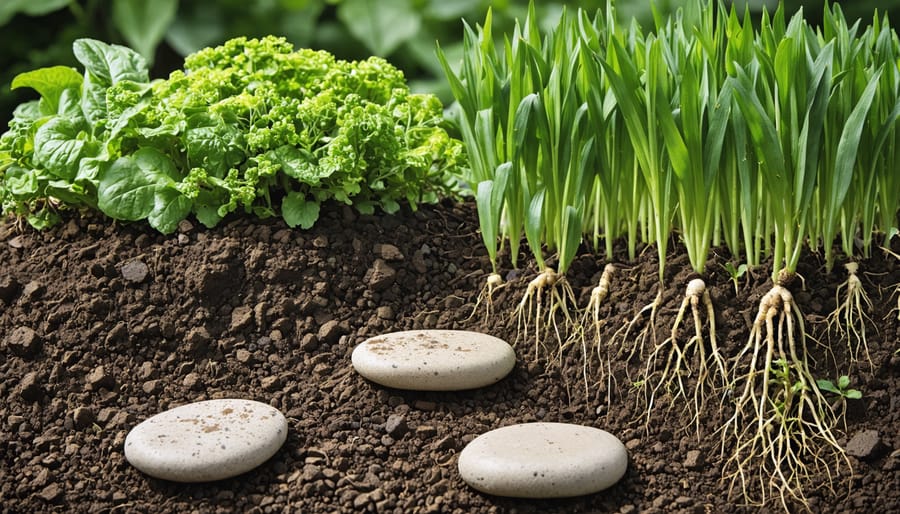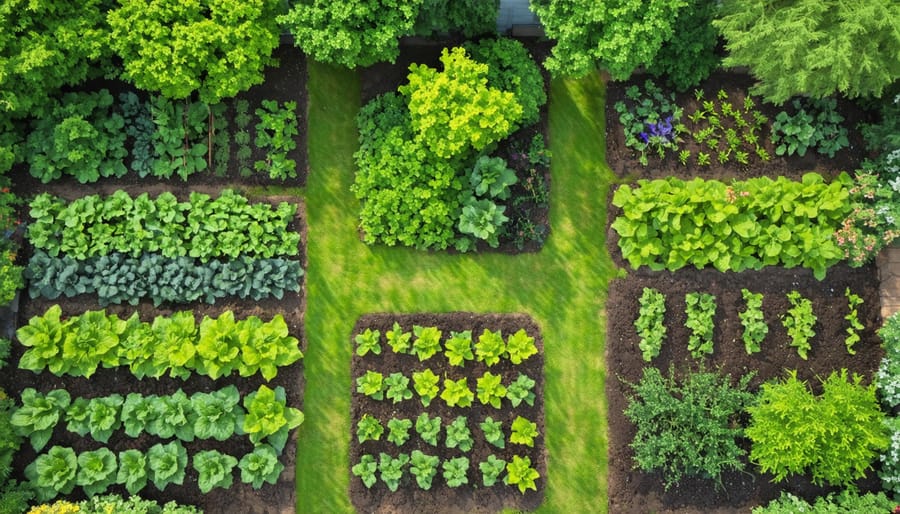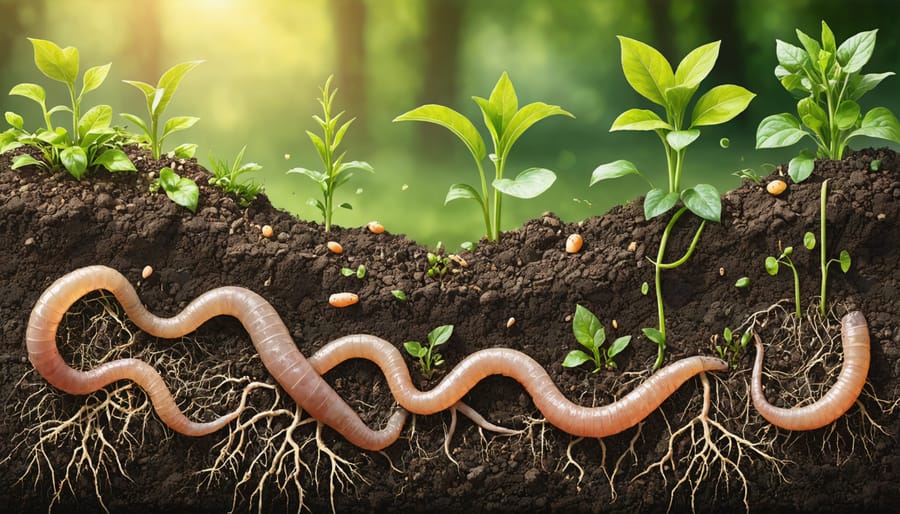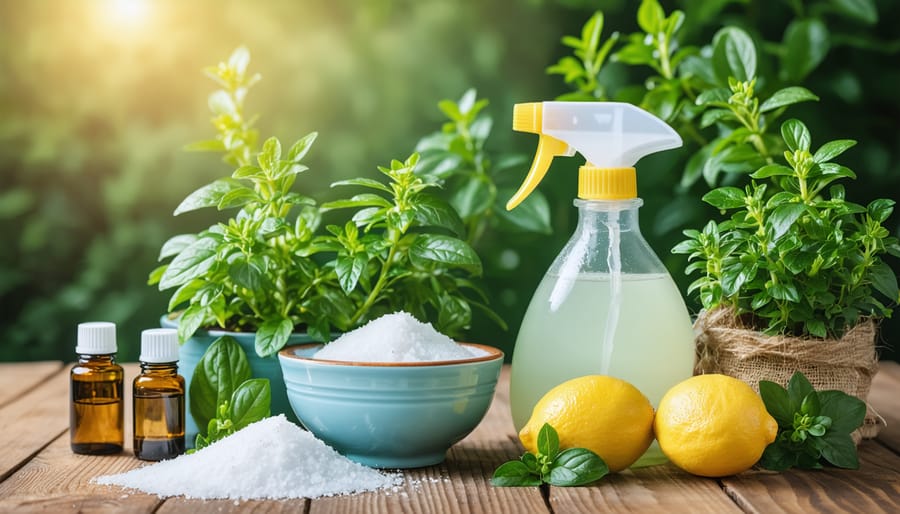Break up compacted soil naturally by introducing earthworms and beneficial organisms – they create vital air channels while enriching your garden’s ecosystem. Spread a 3-inch layer of organic mulch across affected areas, allowing nature’s decomposers to gradually restore soil structure. Establish dedicated pathways in your garden to prevent future compaction, using stepping stones or wood chips to distribute weight evenly. Plant deep-rooted cover crops like daikon radish and alfalfa in problem areas – their robust root systems naturally penetrate and loosen dense soil layers while adding organic matter.
When working with compacted soil, timing matters. Test soil moisture by squeezing a handful – it should crumble easily, not form a sticky ball. This sweet spot between too wet and too dry is ideal for soil improvement work. Whether you’re growing vegetables or maintaining flowerbeds, healthy soil structure forms the foundation of a thriving garden. These gentle, natural solutions work with your soil’s biology to create lasting improvements without damaging delicate root systems or beneficial microorganisms.
Signs Your Garden Soil is Compacted
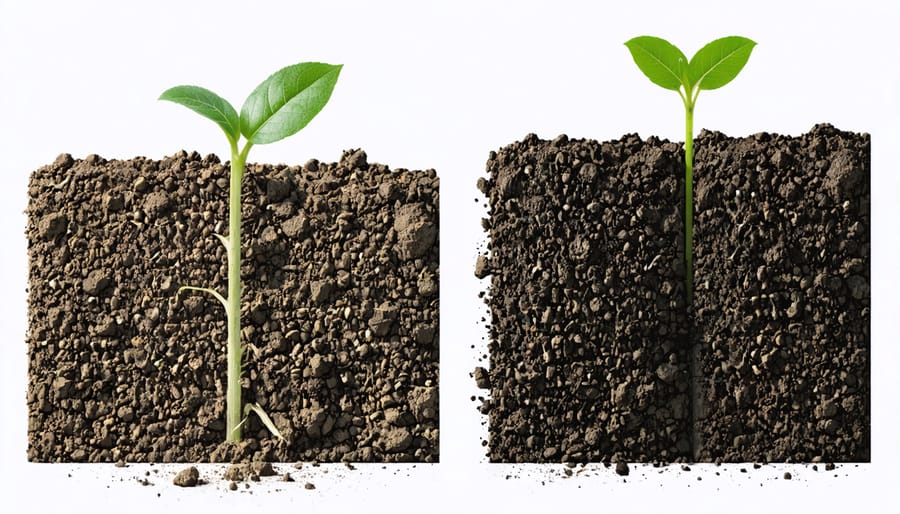
Visual Indicators
Identifying soil compaction doesn’t require special equipment – your eyes and hands can tell you a lot about what’s happening beneath the surface. One of the most obvious signs is water pooling on the soil surface long after rainfall or irrigation, creating puddles where water should normally drain away. You might also notice stunted or yellowing plants, as their roots struggle to penetrate the dense soil and access nutrients.
Take a walk through your garden after rain – if you see crusty, hard surfaces or paths where nothing seems to grow, that’s another telltale sign. Look for patches where weeds like plantain and knotweed thrive, as these plants actually prefer compacted soil conditions. Your vegetables might be giving you hints too – if carrots or other root crops grow twisted or deformed rather than straight, compacted soil is likely the culprit.
Try this simple test: push a garden fork into your soil. If you meet significant resistance or can’t push it in more than a few inches, you’re dealing with compaction. Healthy soil should allow the fork to slide in smoothly with moderate pressure.
Simple DIY Tests
Testing your soil for compaction doesn’t require fancy equipment or professional services. You can perform several simple soil tests at home to determine if compaction is affecting your garden’s health.
The Wire Test: Push a thick wire or coat hanger into your soil. If you meet significant resistance before reaching 6-8 inches deep, you likely have compaction issues. Try this test in multiple spots, as compaction can vary throughout your garden.
The Shovel Method: Dig up a small section of soil with a garden spade. If the soil comes up in large, solid chunks that are difficult to break apart, or if you struggle to push the shovel into the ground, these are clear signs of compaction.
The Water Test: Pour a cup of water onto your soil and time how long it takes to absorb. If the water pools for more than a minute or runs off instead of soaking in, your soil might be too compacted for proper drainage.
Remember to perform these tests when your soil is neither too wet nor too dry for the most accurate results. These simple checks can help you identify problem areas before they affect your plants’ growth.
Natural Solutions for Soil Compaction
Cover Crops That Break Up Compacted Soil
Cover crops are nature’s way of breaking up compacted soil, and they’re a gardener’s secret weapon for improving soil structure without breaking a sweat. These hard-working plants send their roots deep into the earth, creating natural pathways that loosen tight soil and improve drainage.
Daikon radish, often called the “bio-drill,” is one of the most effective cover crops for breaking up compaction. Its long taproot can penetrate up to six feet deep, creating channels that remain even after the plant decomposes. Alfalfa is another champion, with roots that can reach depths of 15 feet or more while adding valuable nitrogen to your soil.
For fall planting, consider winter rye, which develops an extensive root system that excels at breaking up compacted layers. Clover varieties, particularly red clover, are perfect for smaller gardens and can be planted in spring or fall. They not only help with compaction but also attract beneficial pollinators to your garden.
For best results, plant your cover crops densely and let them grow for at least a few months before turning them into the soil. This gives their roots time to work their magic. As an added bonus, when you eventually incorporate these plants back into the soil, they’ll decompose and add organic matter, further improving your soil’s structure and health.

Organic Matter and Mulching
Adding organic matter to your soil is like giving it a natural vitamin boost! As organic materials decompose, they create a rich, loose environment that helps improve soil structure and combat compaction naturally. Start by incorporating compost, well-rotted manure, or leaf mold into your garden beds.
Mulching is another fantastic way to enhance soil health. Apply a 2-3 inch layer of organic mulch, such as straw, wood chips, or shredded leaves, around your plants. This protective blanket does double duty: it prevents soil from becoming compacted by heavy rain while gradually breaking down to add vital nutrients to your soil.
Consider using “green manures” or cover crops during off-seasons. Plants like clover or rye create a living mulch that protects soil from compaction while their roots naturally aerate the ground. When these plants are later turned into the soil, they decompose and further enrich your garden bed.
For best results, add organic matter annually in spring or fall. You’ll notice the difference as your soil becomes darker, crumblier, and more alive with beneficial organisms. Remember to avoid walking on mulched areas to maintain the benefits of your organic additions. Your plants will thank you with vigorous growth and improved health!
Beneficial Organisms
Nature’s own soil engineers play a crucial role in preventing and alleviating soil compaction. Earthworms are perhaps the most visible heroes in this underground story, creating channels and burrows that act as natural pathways for water, air, and plant roots. As these wonderful creatures tunnel through the soil, they break up compacted layers and improve soil structure naturally.
When earthworms digest organic matter, they create nutrient-rich castings that help bind soil particles together in a way that resists compaction. These castings also provide food for beneficial soil microorganisms, creating a thriving ecosystem beneath our feet.
But earthworms aren’t working alone! Countless microscopic organisms, including bacteria and fungi, contribute to soil health by breaking down organic matter and creating natural glues that help form soil aggregates. These aggregates create spaces between soil particles, preventing them from becoming tightly packed together.
To encourage these helpful creatures in your garden, maintain consistent moisture levels and add organic matter regularly. A layer of mulch provides both food and shelter for earthworms and other soil organisms. Avoid using chemical pesticides and fertilizers that might harm these natural allies. Remember, a healthy population of soil organisms is one of the most effective long-term solutions for preventing soil compaction.
Mechanical Solutions Without Heavy Equipment

Hand Tools for Soil Aeration
Hand tools for soil aeration offer a practical and budget-friendly solution for small to medium-sized gardens. The most common and effective manual aerator is the fork-style aerator, which features solid tines that pierce the soil to create breathing spaces. When using this tool, aim to insert it about 4-6 inches deep, gently rock it back and forth, and then move on to the next spot, spacing holes about 4-8 inches apart.
For smaller areas or targeted aeration around specific plants, a manual core aerator is invaluable. This tool removes small plugs of soil, creating lasting channels for air, water, and nutrients. While it requires more effort than a fork-style aerator, it’s particularly effective for severely compacted soil.
The spike aerator shoe is another handy tool – simply strap these spiked soles onto your boots and walk around your garden area. While not as effective as other methods, it’s a convenient option for light soil compaction issues.
A garden fork can double as an aerating tool in a pinch. Work it into the soil at a slight angle, then pull back gently to create small gaps. For the best results, aerate when the soil is slightly moist but not waterlogged – typically a day after light rain or watering.
Remember to clean your tools after each use and store them in a dry place to prevent rust and extend their lifespan.
Raised Beds and No-Till Methods
Raised beds and no-till gardening methods offer excellent solutions for preventing soil compaction while promoting healthy plant growth. Raised beds naturally avoid compaction issues since you’re not walking on the growing area, and the soil remains loose and well-aerated. Build your beds 12-24 inches high and 3-4 feet wide, allowing you to reach the center from either side without stepping into the bed.
No-till gardening takes inspiration from nature, where soil remains undisturbed and builds structure naturally. Instead of turning or tilling the soil each season, simply add organic matter on top and let earthworms and beneficial organisms do the work. Layer compost, leaves, and mulch on your beds, and plant directly into this enriched soil. Over time, this creates a self-maintaining system with excellent drainage and natural aeration.
For existing gardens, transitioning to these methods is straightforward. Start by marking out your raised bed areas and building simple frames with untreated wood or recycled materials. Add your soil mix in layers, incorporating plenty of organic matter. For no-till areas, begin by adding a thick layer of compost and mulch over your current soil, and avoid disturbing it except when planting.
These methods not only prevent compaction but also improve soil health, reduce watering needs, and make gardening more enjoyable with less back-straining work.
Prevention Strategies
Smart Garden Planning
Smart garden design can prevent soil compaction before it becomes a problem. Start by creating dedicated pathways using stepping stones, mulch, or gravel to direct foot traffic away from planting areas. These paths should be easily accessible and wide enough for comfortable movement with gardening tools.
Consider raised beds or containerized gardening, which naturally protect soil structure by eliminating the need to walk on growing areas. If you’re working with in-ground beds, make them narrow enough to reach the center from either side – typically no wider than 4 feet – to avoid stepping into the bed while maintaining plants.
Zone your garden based on maintenance needs. Place high-maintenance plants that require frequent attention near paths or garden edges, while low-maintenance perennials can go in less accessible areas. This strategic placement reduces the need to walk on soil.
Install a simple irrigation system to eliminate the need to drag heavy hoses across your garden. Additionally, incorporate permanent features like benches or tool storage near frequently visited areas to minimize random foot traffic. Remember, prevention is always easier than cure when it comes to soil compaction.
Seasonal Maintenance Tips
Maintaining healthy soil structure requires consistent attention throughout the year. In spring, start by avoiding working wet soil, as this can cause severe compaction. Wait until soil crumbs easily fall apart when squeezed to begin your gardening activities. Once the soil is workable, add a layer of organic matter like compost or well-rotted manure to protect soil health and improve structure.
During summer, maintain a layer of mulch around your plants to prevent soil crusting from heavy rains and intense sun. This also helps retain moisture and reduces the need for frequent foot traffic when watering. Consider using stepping stones or designated paths to minimize soil compression in your garden beds.
Fall is the perfect time to plant cover crops like clover or rye, which naturally aerate soil with their root systems throughout winter. These plants also add valuable organic matter when turned under in spring. In winter, avoid walking on frozen garden beds, as this can damage soil structure when the ground thaws.
Remember to rotate your plantings annually to prevent repeatedly stressing the same areas of soil, and consider establishing permanent raised beds to eliminate the need for yearly tilling.
Taking care of compacted soil doesn’t have to be an overwhelming task. By implementing the solutions we’ve discussed, you can transform your garden’s hard, lifeless earth into rich, loose soil that your plants will love. Remember that prevention is just as important as treatment – mulching regularly, avoiding walking on garden beds, and maintaining proper moisture levels will help keep soil compaction at bay.
Start with simple solutions like adding organic matter and using cover crops, then gradually work your way up to more involved methods if needed. Every garden is unique, so don’t be afraid to experiment with different approaches to find what works best for your space. The key is to be patient and consistent with your soil improvement efforts.
Your garden will thank you for your dedication with healthier plants, better yields, and an overall more vibrant growing space. Take action today by choosing one or two methods to implement this season. Whether you start with a layer of compost, plant some deep-rooted cover crops, or begin using raised beds, any step toward improving your soil is a step in the right direction.
Remember, healthy soil is the foundation of a thriving garden. By addressing soil compaction, you’re not just solving a problem – you’re investing in your garden’s future success. Let’s get started on your soil improvement journey today!

